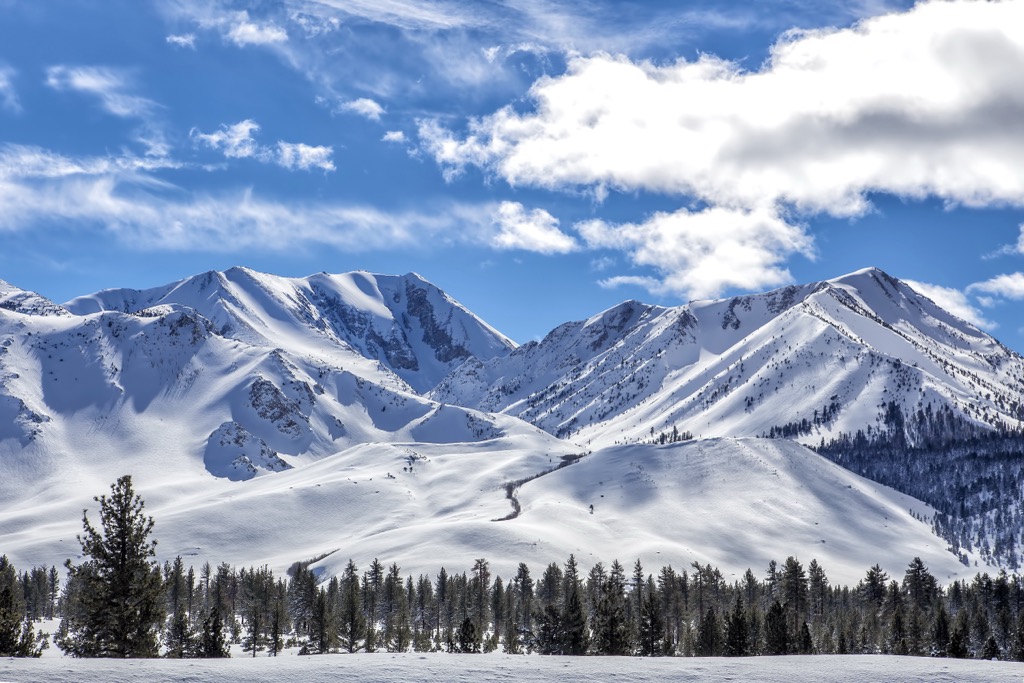Get PeakVisor App
Sign In
Search by GPS coordinates
- Latitude
- ° ' ''
- Longitude
- ° ' ''
- Units of Length
- Temperature

Yes
Cancel
Share ×

Scan the QR code and open PeakVisor on your phone
❤ Wishlist ×
Choose
Delete
Mammoth Mountain is the 4th largest of more than 30 ski resorts in the state of California on the border with Nevada in the US. The resort is located on Mammoth Mountain (11,023 ft / 3,360 m), the 57,000-year-old lava dome complex. The main features of the ski resort are deep snows, the massive scale of alpine terrain, the unparalleled views of the Sierra Nevada Range, and the large skier capacity. There are 175 named runs over 3,500 skiable acres (1,416 ha) or more than 56 mi (90 km) and 25 ski lifts at the resort. It is best suitable for intermediate skiers, but there are also plenty of easy and advanced slopes, as well as more than 19 mi (32 km) of Nordic ski trails. The Mammoth Mountain ski season is from mid-November to at least mid-June, and sometimes into August.
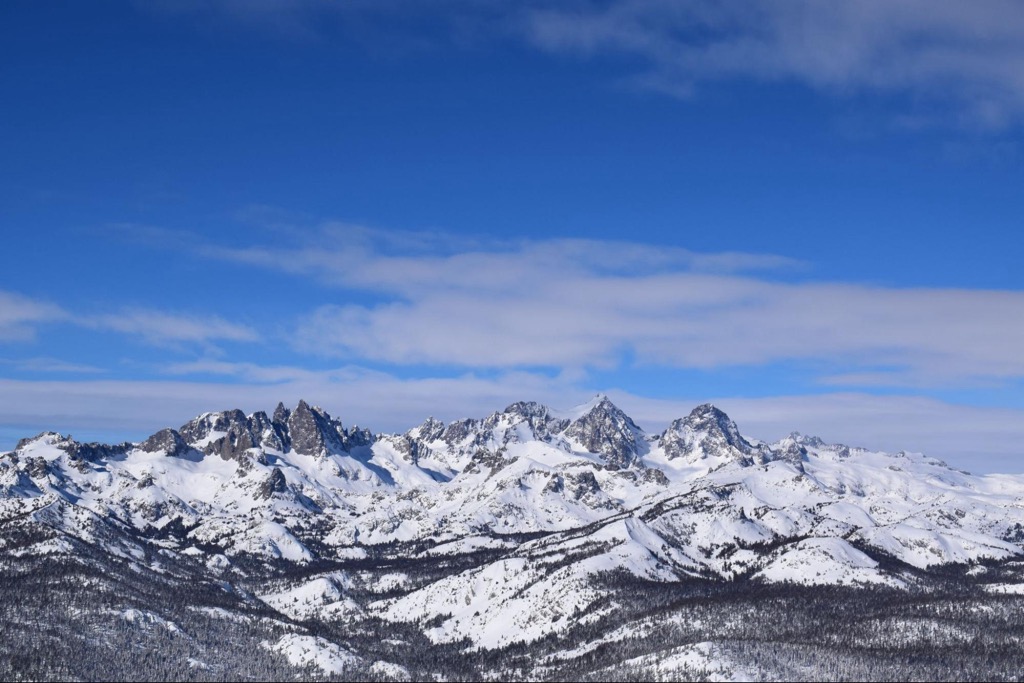
Mammoth Mountain offers the best views of the Minarets, a series of spire-like peaks that reach 12,264 ft (3,738 m). In the photo, they are on the left half, and Mt. Ritter (13,150 ft / 4,008 m) is on the right. Sergei Poljak
Founded in 1955 by the legendary American skier and businessman Dave McCoy, Mammoth Mountain has become one of the US's oldest and most celebrated ski resorts. McCoy ran the area for 68 years before retiring in 2005.
The ski resort was sold for $365 million, generating quite the return on investment from the $135,000 loan in 1955. Despite retiring at 89 years old, McCoy enjoyed 15 golden years. He continued to ski until the age of 92 and died peacefully in 2020 at the age of 104. Few individuals have impacted the sport of skiing as much as Dave McCoy.
Mammoth Mountain Ski Resort sits squarely within the Inyo National Forest in the Sierra Nevada Range. Colloquially, the mountain is in the Eastern Sierra, referring to the high peaks that tower over the Owens River Valley on the eastern half of the range. These mountains are some of the most prominent in the contiguous US — North Palisade Peak (14,248 ft / 4,343 m) is over 10,000 ft (3048 m) higher than the town of Bishop, which is just a few miles away.
The resort itself is in the town of Mammoth Lakes in Mono and Madera counties of California. Mono Lake is visible to the north from the resort’s upper elevations. To the east are the northern reaches of the Owens River Valley and the massive White Mountain Peak (14,252 ft / 4,344 m).
Yosemite National Park is near Mammoth as the crow flies, but access over the Tioga Pass is closed for most of the year (generally, October to June). The drive takes 45 minutes during the summer when the pass is open. However, it takes six hours when the pass is closed.
Mammoth Mountain (11,023 ft / 3,360 m) is host to the eponymous ski resort, which occupies its entire northern and some of its southern half. Mammoth is a lava dome complex formed during a series of eruptions approximately 57,000 years ago.
The volcano is active. Today it produces several fumaroles around the Mammoth Lakes area. A large area of tree death near Mammoth Lakes is attributed to high levels of CO2 in the soil. In 2006, three ski patrollers at Mammoth Mountain died after falling into a fumarole while trying to secure a perimeter. In 1980, an earthquake in the region caused a real estate panic when residents began anticipating a Mt. St. Helens-esque eruption.
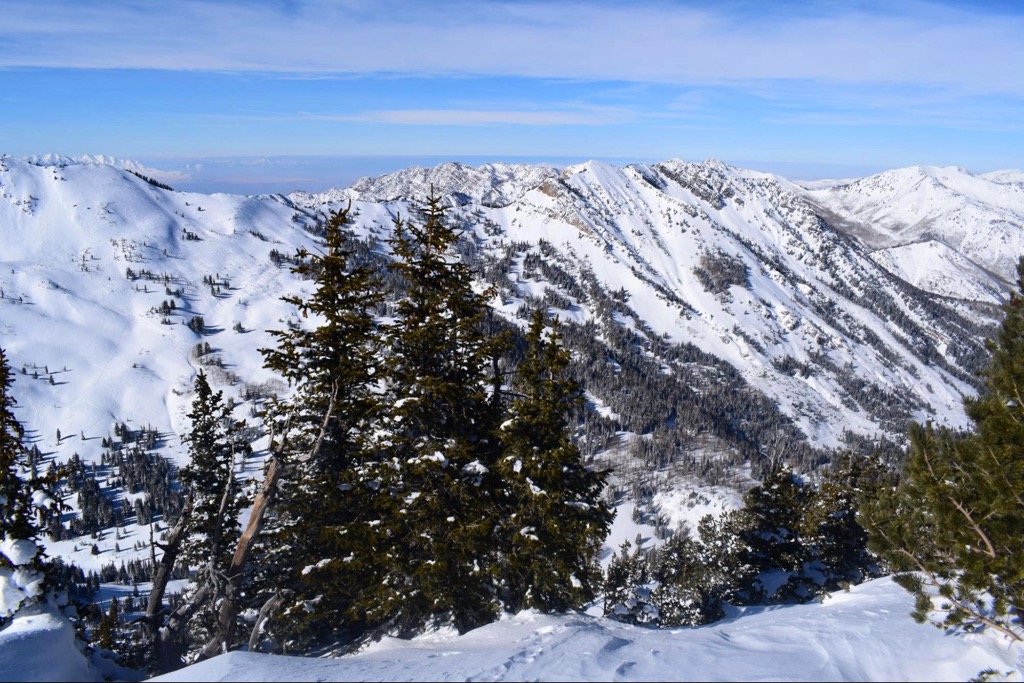
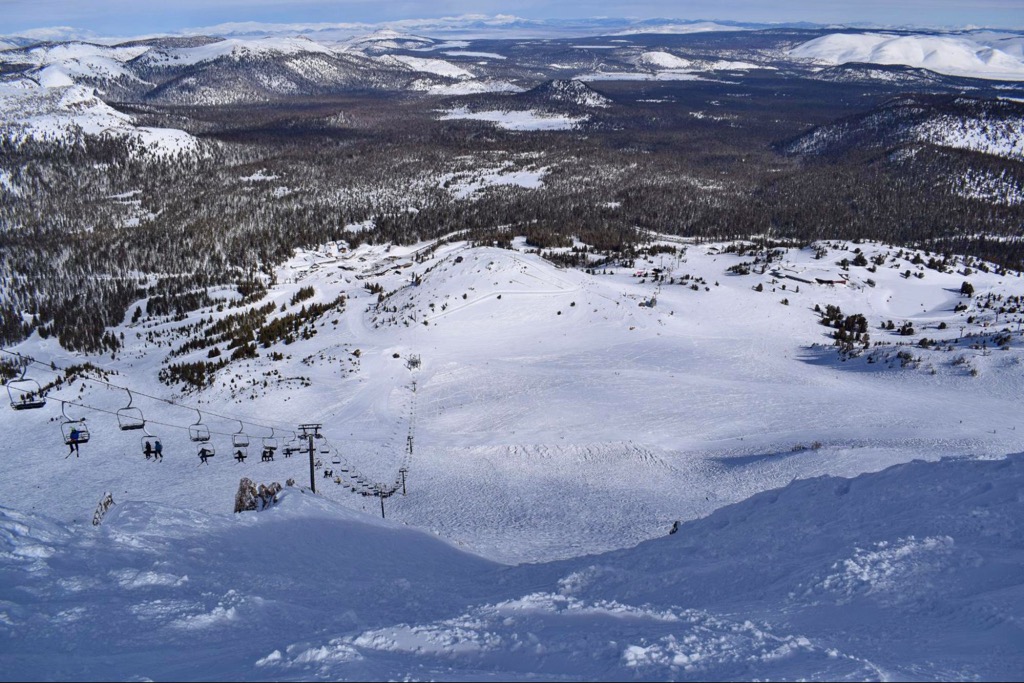
Historically, Mammoth Mountain Ski Resort has been a destination predominately reached by car. However, the region has recently developed local airports to drum up air traffic. Now it’s possible to fly to Bishop (45 minutes south of town) from almost anywhere.
There are two ways to fly to Mammoth:
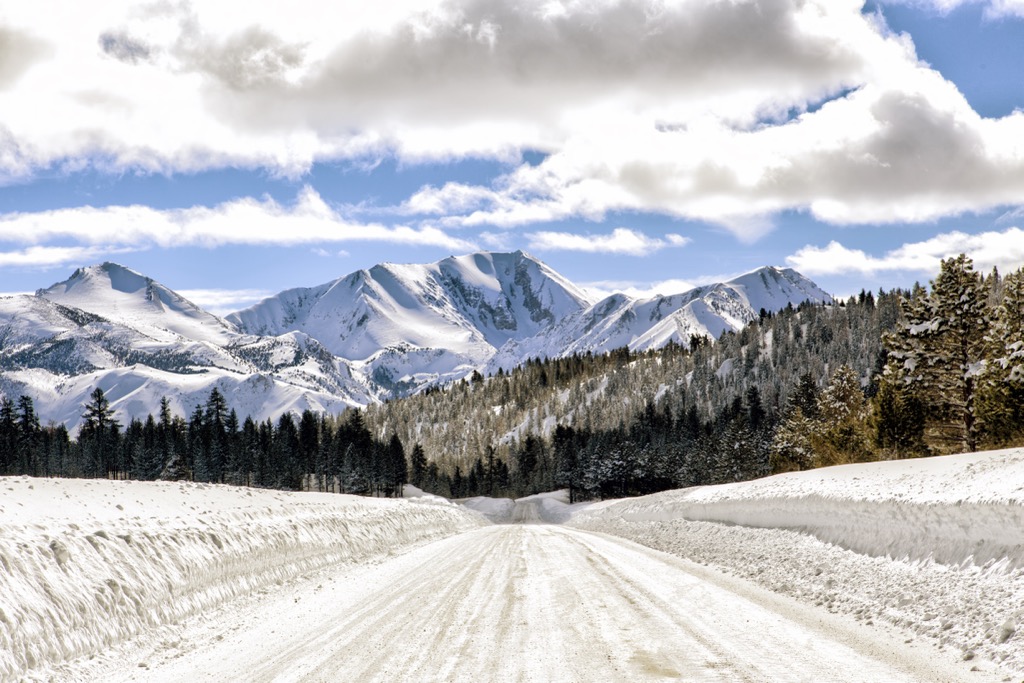
Driving to Mammoth Mountain Ski Resort is easy and an excellent option for folks living out west. It is only five hours from Los Angeles and Las Vegas, and many skiers here are from those two cities.
Mammoth is the go-to resort for all the serious skiers in Southern California, so expect some traffic on Fridays and Sunday nights on the 395, the main artery cutting through the Owens River Valley. 395 isn’t an interstate — it’s just one lane in many spots — and traffic can get backed up.
The nearest large city is Reno, Nevada, just over three hours by car. Mammoth Resort is also within a day’s drive from many other cities out west, including San Diego, Los Angeles, San Francisco, Sacramento, Portland, Reno, Las Vegas, Phoenix, Boise, and Salt Lake City.
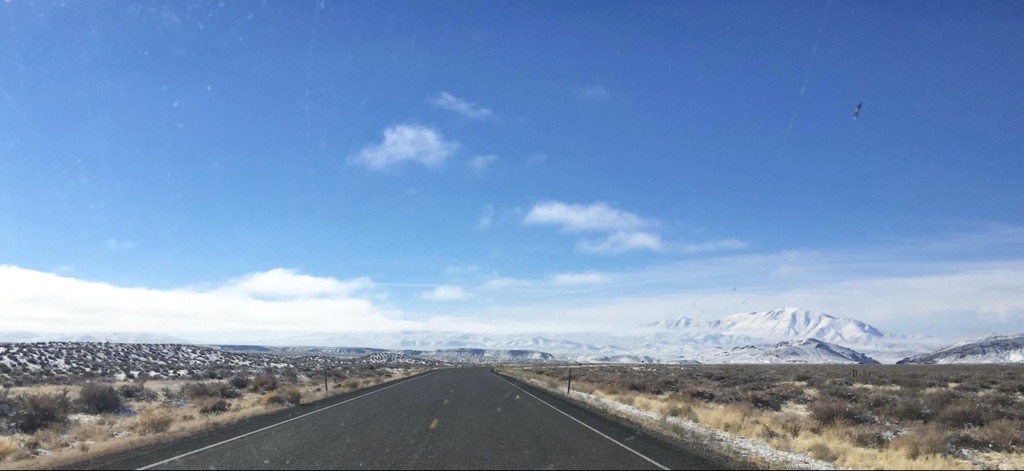
There’s a lot of parking at Mammoth Mountain, but often even more skiers. The imbalance is especially pronounced on weekends as everyone drives up from LA.
The parking is complex and impossible to describe in this guide. Fortunately, Mammoth has detailed maps on its website outlining the whole situation.
Some parking is paid, some is free, some is loading-only, some is short-term, and some is long-term, so be aware of the fine print. Free parking shuttles run frequently for those who have to park far away. If you stay in town, ditch the car and take the free public transportation to the resort. It will save you time and effort.
Mammoth consists of three main zones: the Main Lodge base area, the village core, and the downtown of Mammoth Lakes. Getting to and from all these places is easy as pie thanks to the Free Mountain Shuttle Service from morning until late and the Dial-a-Ride (no more than a few dollars) services during the day. The bus stations are well-marked and conveniently located.
The Dial-a-Ride service is a killer deal. It’s subsidized by the town to prevent drunk driving accidents. There’s never any excuse to drive drunk. Still, any incentive to do so has now been completely eliminated — you can hail a ride from anywhere in the vicinity, anytime, for virtually no money.
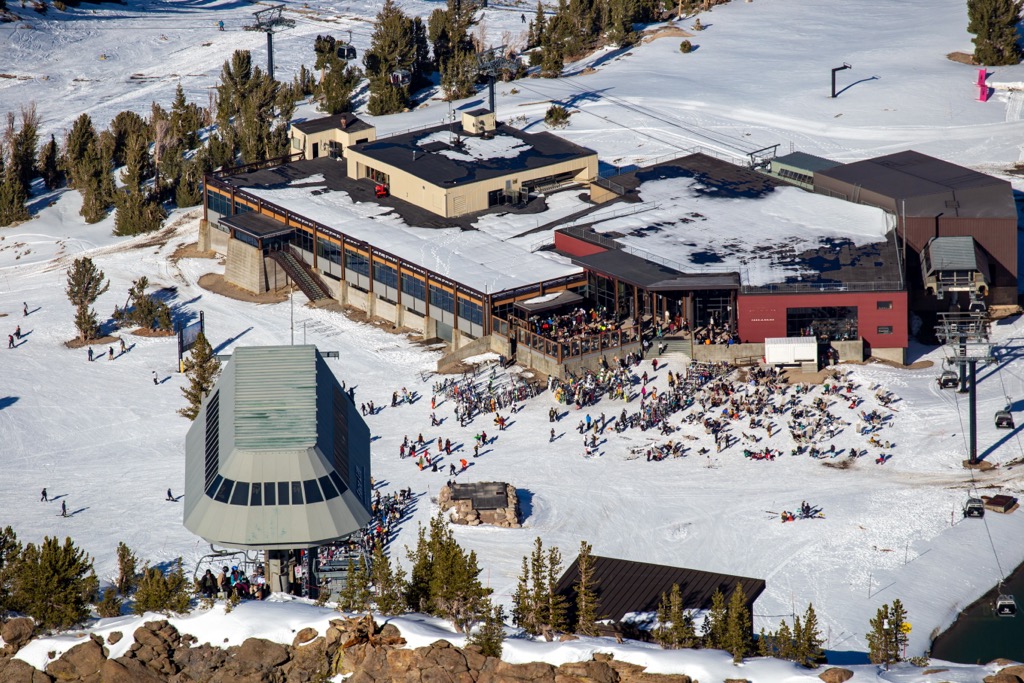
The snow season in Mammoth Mountain Ski Resort is one of the longest in the US. The season typically lasts from mid-November to at least mid-June. The mountain opens as soon as conditions allow, which can be as early as October in some years. They try to stay open until at least July 4th in the summer. The longest season on record was 1994–95, which lasted ten months, stretching from October to August.
Because the winter tends to stick around in Mammoth, each season consists of several phases. It’s difficult to pinpoint the best time to visit. It just depends on what you’re looking for in your experience.
The long seasons here are an incredible anomaly for this latitude. Sure, glacier chairlifts are open all summer in Europe, but Mammoth is at 37 degrees latitude — the same as the northern tip of Africa: Morocco, Tunisia, and Algeria. The resort’s altitude, extensive north-facing terrain, and abundant snowfall all contribute to the duration of the snowpack well into summer.
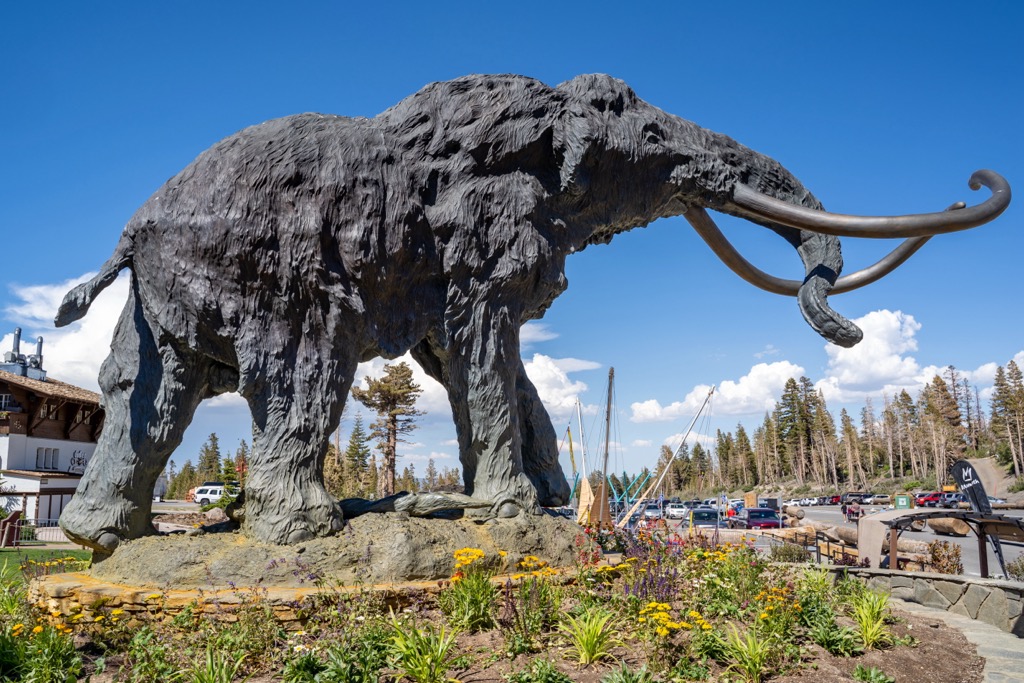
There are very few cloudy days in Mammoth. The sun is shining when it’s not snowing, and the resort boasts over 300 days of sunshine annually.
The diversity of snow you can experience at Mammoth Mountain Ski Resort is also impressive. The skiing quality and type varies daily, month-to-month, and year-to-year.
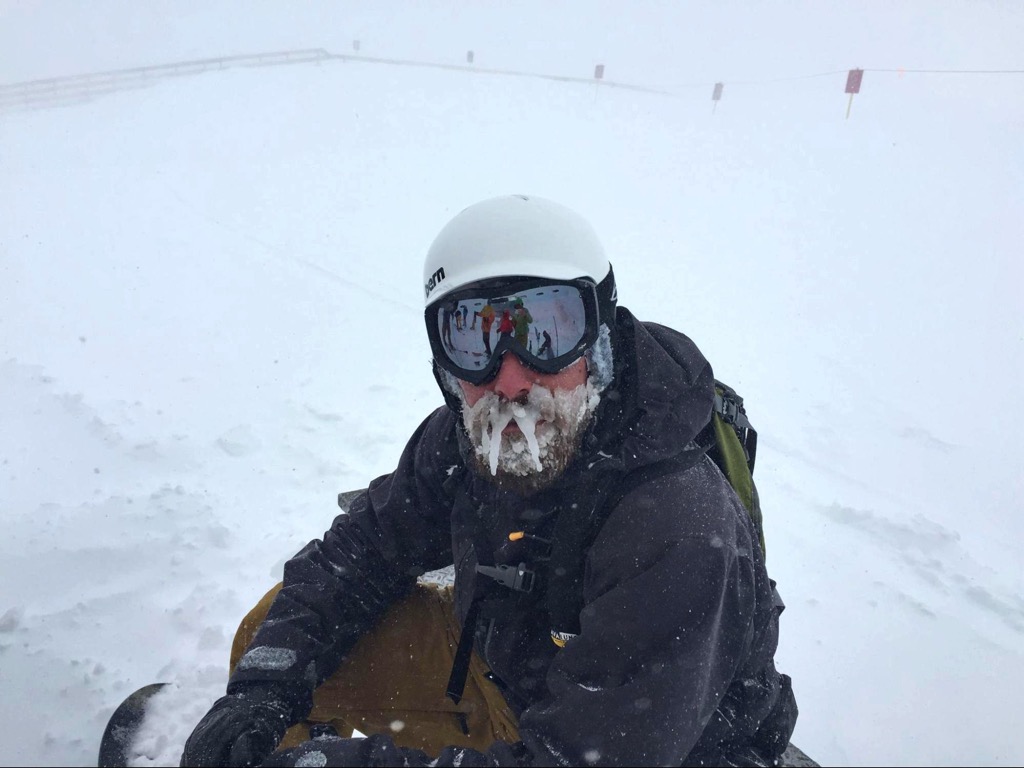
Mammoth averages over 400 in (10 m) of snow at the Main Lodge (8,909 ft / 2,715 m). Main Lodge isn’t even halfway up the mountain. The summit of Mammoth receives significantly more. Measuring snowfall at the summit is challenging because the wind can often blow over 100 mph (162 kph) during storms. I give Mammoth a lot of credit for this. Jackson Hole, for example, reports from a bowl at the top of the mountain, where the snow is deeper than everywhere else.
However, the snowfall in Mammoth is not always reliable year-to-year. It’s feast or famine here. The big years can be spectacular, but the lean years will test the spirit of even hardened locals. The 1975–76 season saw only 94 in (238 cm) of snow, a record low for the resort. Dave McCoy nearly went out of business during a drought in 1958–59. Presently, the state of California and the west have been in a 20-year ‘megadrought,’ though Mammoth has had several 500+ in (1,270 cm) seasons in this time. Nevertheless, overall precipitation has declined during this period.
The crux of the issue is the storm track. Sometimes storms from the Pacific are blocked by a ridge of high pressure that tends to develop in the southwestern United States. This ridge is remarkably resilient in some seasons, while others feature a more dynamic pattern. Long-term weather forecasting is far from an exact science, but the weather pattern known as El Nino produces the best winters for Mammoth, statistically speaking. It tends to shift the storm track south. Of course, there have also been dry El Nino and wet La Nina years.
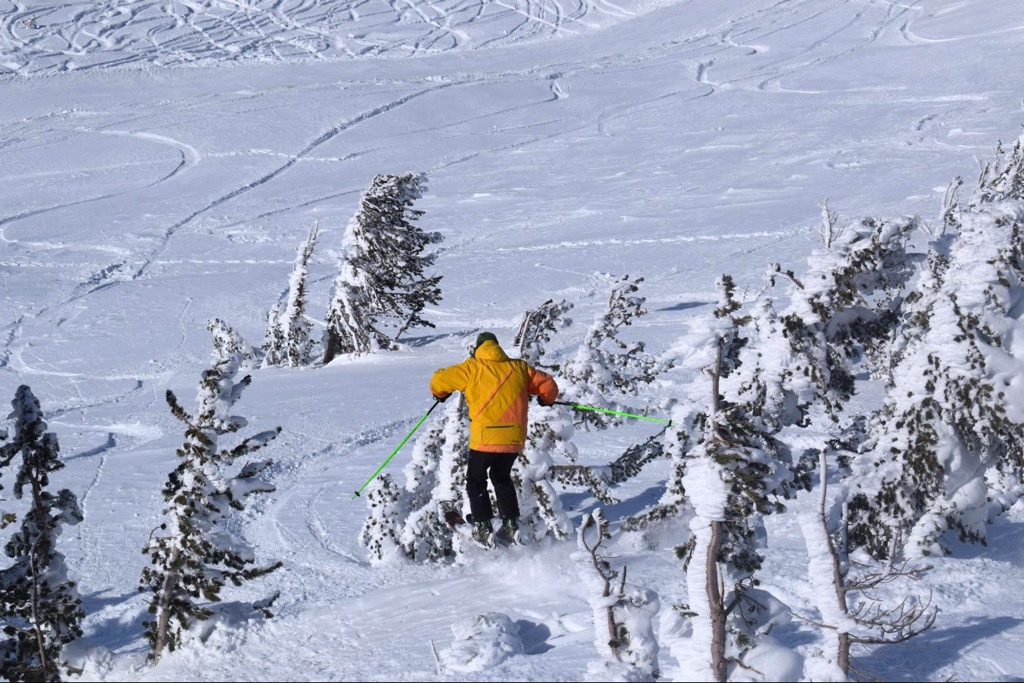
Mammoth is an excellent place for many types of skiing, but it is the best place in the US, and probably the world, to ski the wind-affected powder skiers call ‘wind-buff.’ This unique surface is creamy and supportive yet soft and bouncy. Skis respond with laser precision to your every command. Tracks disappear in minutes, leaving a fresh slate for the next skier. These are my favorite days at Mammoth; you will find a crew of locals who feel the same way. Unlike the big bluebird powder days, there aren’t many people around, and it is an all-you-can-ski freshies bonanza.
Twenty-three laps on Chair 23 is the magic number. Once you’ve bested that challenge, see if you can reach the bottom in 23 turns. It’s not a bad way to dial in your 328 ft (100 m) turning radius.
The downside to these howling days is that the winds are often obnoxious to skiers or affect lift operations on Chair 23 or the Summit Gondola. But if you can brave the elements, enlightenment lies ahead.

Every season is different, and no science can predict precisely when the best conditions will be. But we can use statistics to make an educated guess about the conditions we might experience during a given period.
Early season. This time in Mammoth Ski Resort is any time before Christmas. Like any ski area, it is hit or miss in the early season. However, you have a higher chance of scoring good conditions here early in the season than almost anywhere else in the country. Mammoth often gets snow from atmospheric river storms that dump feet of snow at a time. It only takes one of these to set the base up for the season and open up most of the mountain.
Mammoth is one of the few places where skiing actually gets easier as the season progresses. The upper mountain bowls fill in with so much snow that they lose pitch. The couloirs become wide or cease to become couloirs at all. Any rocks are liable to be buried by March.
Skiing during Christmas frequently means strapping on your gear, waiting in line, and skiing down whatever groomer the resort has blown snow on. Even in Telluride, where I lived for years, Christmas would usually be very thin, with lots of rocks and grass poking up anywhere besides the groomers. For some folks, that’s quite enough. But PeakVisor’s readership has much higher standards. Mammoth is usually much more filled in by this time, and the mountain deserves credit for that.
Christmas — March. By this time, the jet stream has (hopefully) awoken from its summer slumber, and the storms are marching in one after the other. This period marks the statistically snowiest period of the season. January 2017 broke records with 245 in (6.22 m). The snow is piling up, the sun's angle is low, and the mountain is covered. It’s a great time to visit Mammoth for big powder days and good snow conditions.
March — Early May. Mammoth Mountain is coated in a deep base. Powder days can still happen and can be considerable — especially in March. However, the sun is often out, and the snow begins to transform into that incredible soft spring skiing that California is legendary for. The combination of a moisture-rich snowpack, an intense sun, and dry air creates the perfect spring conditions. Best of all, you have the mountain nearly to yourself. After March, all the tourists have left, and those who remain are a fun mix of locals and passionate skiers.
Summer (May, June, July, and August). This season can sometimes last over three months. Mammoth generally tries to stay open until at least June, with the record closing date being August 17th. As the summer progresses, the skiing becomes relegated to the upper mountain in the morning because the snow is simply too sloppy by the afternoon. Mammoth builds some huge jumps and terrain features, and pros worldwide come here to train.
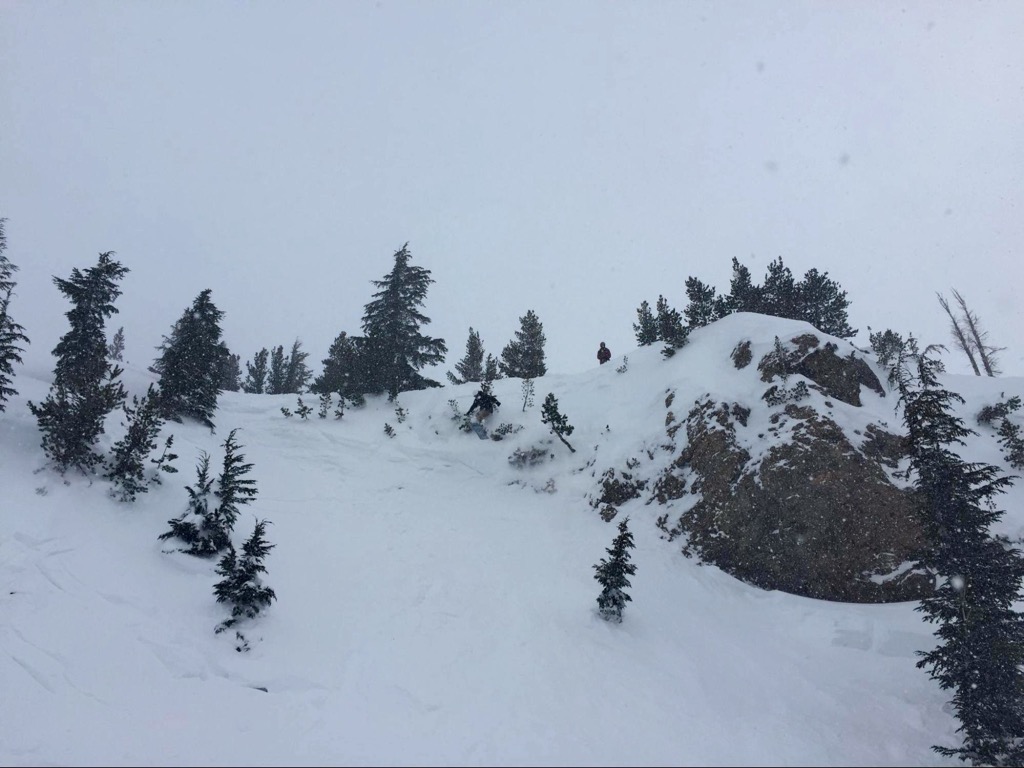
Mammoth Mountain is a behemoth resort with 175 named runs over 3,500 skiable acres (1,416 ha) or more than 56 mi (90 km) and 25 ski lifts, although much of the skiing is off-piste and there are limitless variations through the bowls and trees. The difficulty of the terrain runs the gamut from beginner to expert. But it’s easier to learn your way around than you might think. Here’s what else you need to know:
Like many volcanoes, Mammoth is not only conical but also shaped like a Hershey’s Kiss, meaning the lower mountain is generally lower angled terrain (mainly greens and blues). The upper mountain is steeper and is almost all black and double-black. Two notable exceptions include Chair 22 and the Facelift Express. Chair 22 has some steep rockin’ tree skiing on the lower mountain, while Facelift Express offers excellent blue groomers in an alpine setting up high.
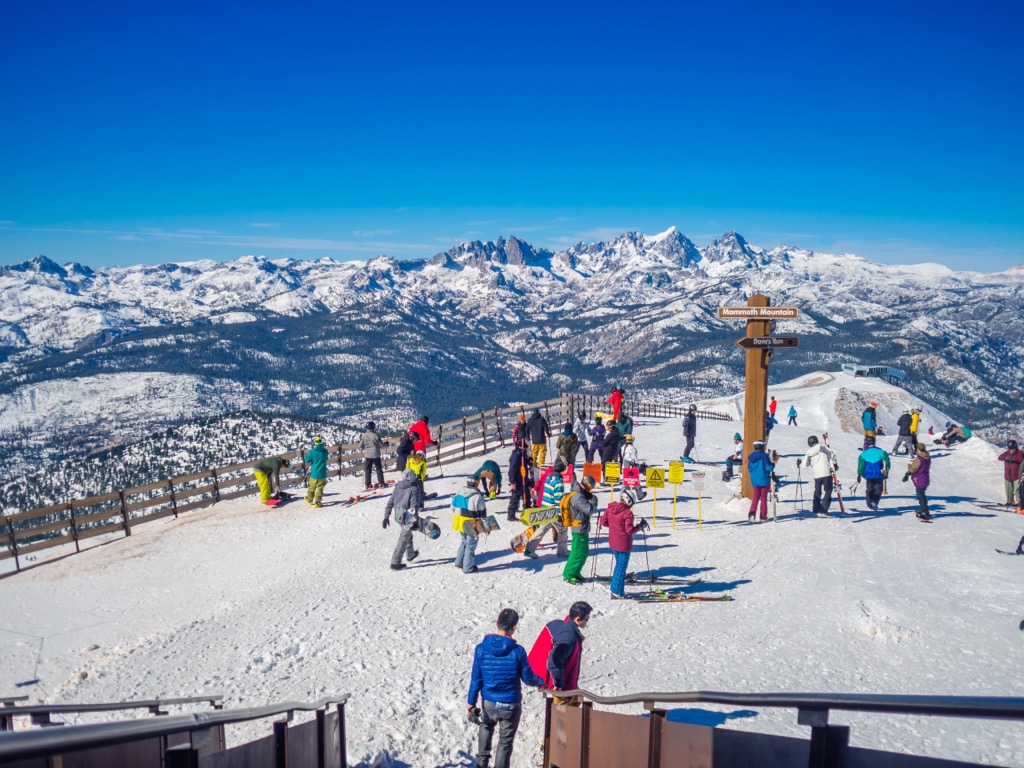
Mammoth Mountain is home to some of the finest quality and diversity of ski terrain in the US. The sheer expanse of skiable acreage means the mountain can cater to skiers of all abilities. As it is (approximately) shaped like a giant Hershey’s Kiss, there is easy terrain on the lower mountain and extremely steep terrain at the top.
The lift system is absolutely state-of-the-art and capable of handling weekend crowds from LA without long queues developing throughout the mountain. Some lines will form at desirable staging points, like the upper panoramic gondola on a powder day. Sometimes large storms force much of the mountain to remain closed, and the lower lifts can get overwhelmed. However, the mountain is relatively devoid of long lift lines when all of the terrain is open. There are so many lifts that chairlift names can be difficult to keep track of — it just takes time.
While Mammoth is not necessarily a hub for absolute beginners, there are plenty of trails for newbies to practice transitioning from snowplow to french fry. The Schoolyard Express and Chair 7 lifts serve the only dedicated beginner area on the mountain, just up from the Canyon Lodge base area. Other green trails are scattered through the lower mountain but are interspersed with intermediate trails and crossings.
Few mountains cater to intermediate and advanced skiers as Mammoth Resort does. For intermediates, there is an abundance of groomed slopes and low-angle off-piste skiing, perfect for skiers looking to hone their technique away from the highway.
Chairs 14, 15, and the Facelift Express offer access to great intermediate groomed runs. Cloud Nine Express, Chair 25, and Rollercoaster Express will take intermediates to easy tree runs and ungroomed slopes. The best resorts offer a progression for skiers. Mammoth has a ton of off-piste skiing, and it’s perfect for progressing skiers through ability levels.
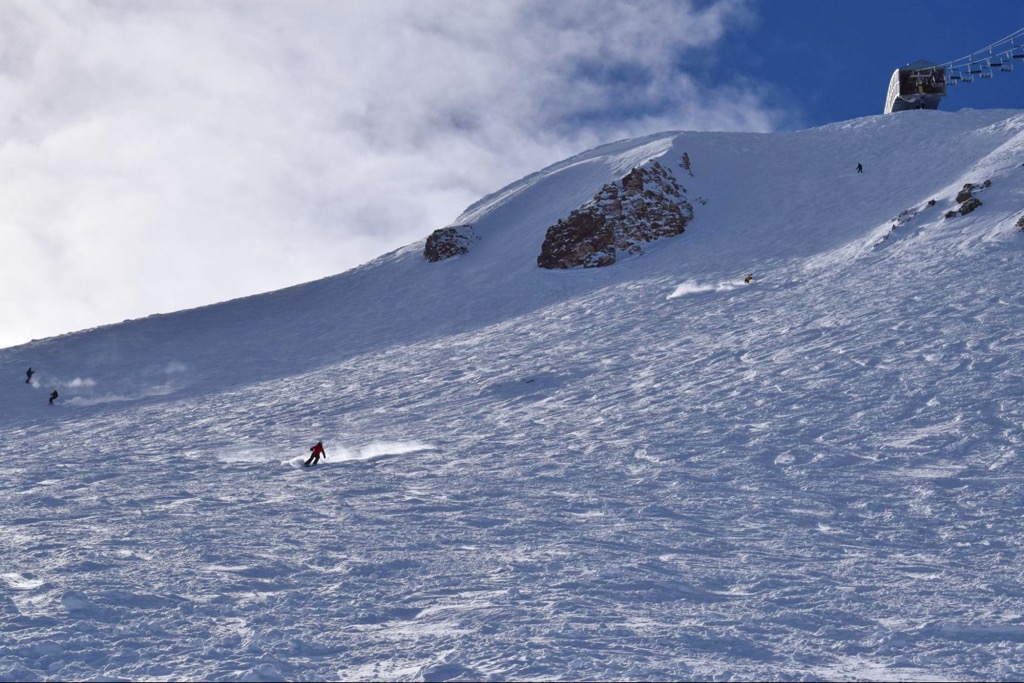
The intermediate off-piste is also fun for experts. Even though the terrain is not steep, it is a lot of fun — especially on those storm days where every lap is a free refill. There are generally dozens of days like this every season in Mammoth since 400+ in (1,016 cm) of annual snowfall doesn’t just materialize out of nowhere. On storm days, the upper mountain will likely be closed. Even if the winds and avalanche danger are in check and the Summit Gondola is open, visibility will be severely limited. Instead of vertigo-inducing descents from the top, the play is to do laps in the trees.
Experts can add the terrain off of Chair 22 to their hit list. I would compare this terrain to KT-22 at Palisades Tahoe: some open spots, trees, and cliffs throughout. Maybe not quite as legendary overall, but this lift is the go-to for experts on any low-visibility day.
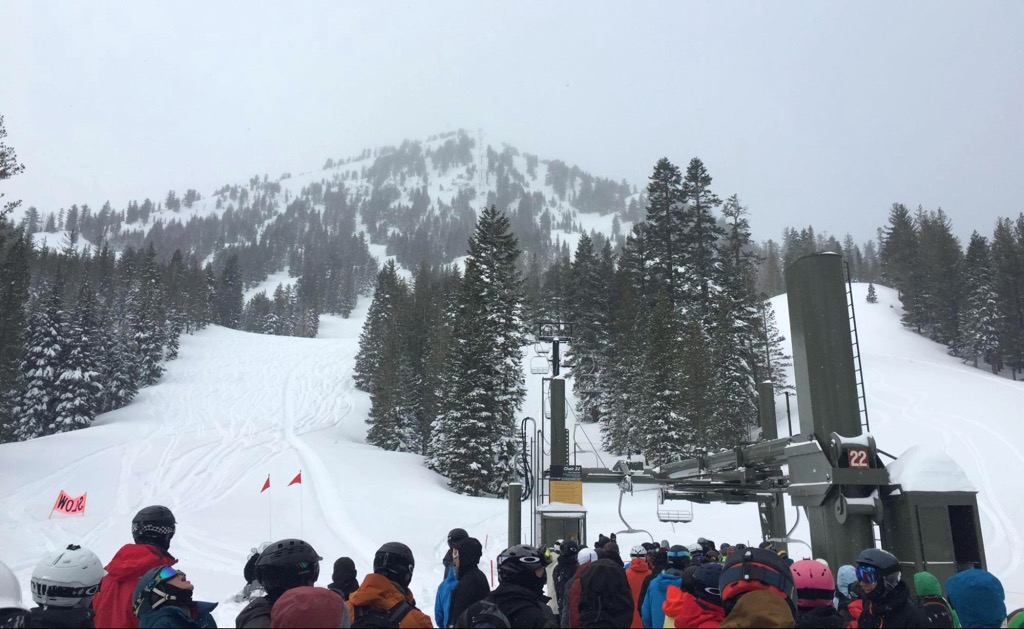
Once the storm clouds roll out, the mountain shows her true colors. Those colors are blue and white. With the sun shining approximately 300 days a year, there is no shortage of bluebird powder days. The mountain gets buried in snow, and the alpine peak becomes a shining mass of white.
Those folks serious about skiing need to be serious about bringing dark lenses for their goggles. The powerful mid-altitude sun and extensive snow coverage have the potential to create snow blindness on a level not seen at other resorts in the States.
Experts will relish these days at Mammoth. The alpine terrain is accessible from two legendary lifts: the Summit Gondola and Chair 23. Skiers take a breathtaking ride up to the ridge, then traverse to choose their adventure. Climax and Cornice Bowl are the two wide-open bowls that offer fairly mellow powder skiing. Several steep chutes will capture the hearts of true experts, including the Wipeout Chutes and Phillipe’s.
However, the ironically-named Kiwi Flats blows the other routes out of the water. This couloir borders on truly extreme skiing. Even when conditions are fat, the winds scour snow away from this chute, littering the path with rocks like a chocolate chip cookie. The pitch registers at a cool 50-something degrees, and a rock band or small cliff is often in the middle. This puppy can be skied with jump turns on most years and ripped in powder on some fat years. Some years the snow doesn’t fly, and it doesn’t get touched. This classic Eastern Sierra testpiece will get the blood pumping no matter what — but if you fall, beware. You’re going the whole way down.
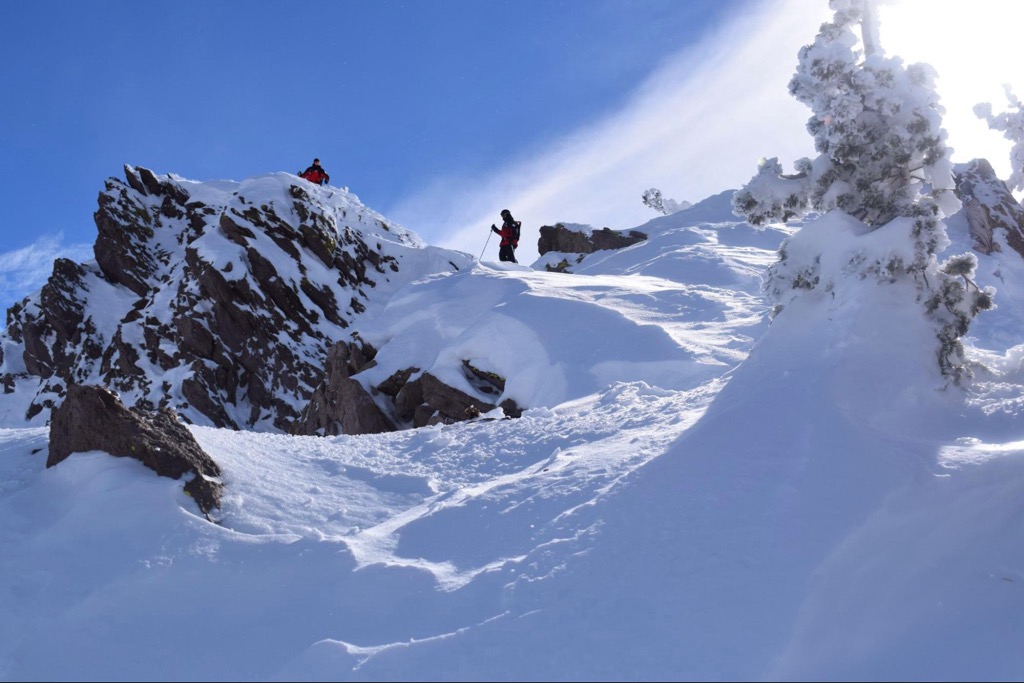
Mammoth also has lift access on the backside of the mountain. This terrain is primarily intermediate, with some tree runs and cut trails interspersed. Chairs 13 and 14 provide access to these slopes and the Outpost restaurant. This side of the mountain is southwest facing and receives a lot of sun, so snow conditions can suffer a lot. But it may also be warm and sunny when the north-facing terrain is cold and windy.
This area becomes severely wind-scoured during storms as westerly winds rip over the mountain. The exception is a small, steep area known as the Hemlocks. These runs are seriously steep and loaded with powder, but they are also short.
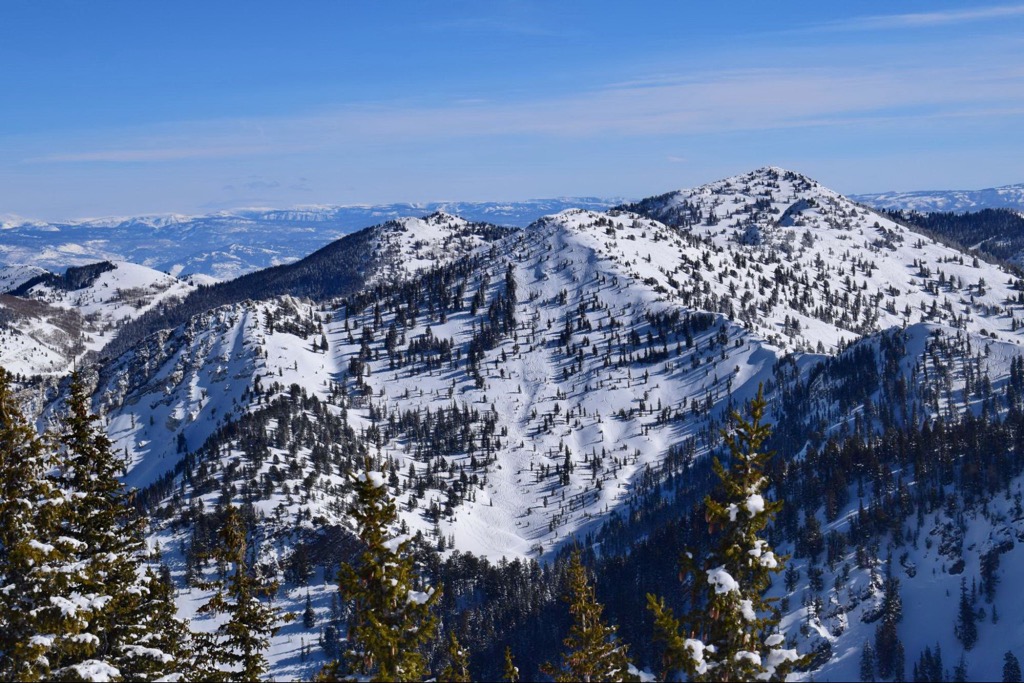
Traversing left off the Summit Gondola will bring you to a vast area of tree skiing known as the Dragon’s Back. It’s steep, with rocks, cliffs, and excellent tree skiing as you traverse farther down. This zone can hold powder long after the other shots along the summit ridge have been chewed up and spit out. However, the traverse over it is long, and the descent is relatively short. Plus, it takes a few lift rides to get back over to the gondola if you want to return to the summit.
Mammoth is not a lift-access backcountry hub. There are a few reasons for this:
Moreover, because this side of the mountain is south-facing, the snow quality can often suffer once the sun emerges. There is one exception to this, however. The Hole-in-the-Wall takes you through a natural lava arch and is worth doing as both a novelty descent and a classic slackcountry descent if conditions are right.
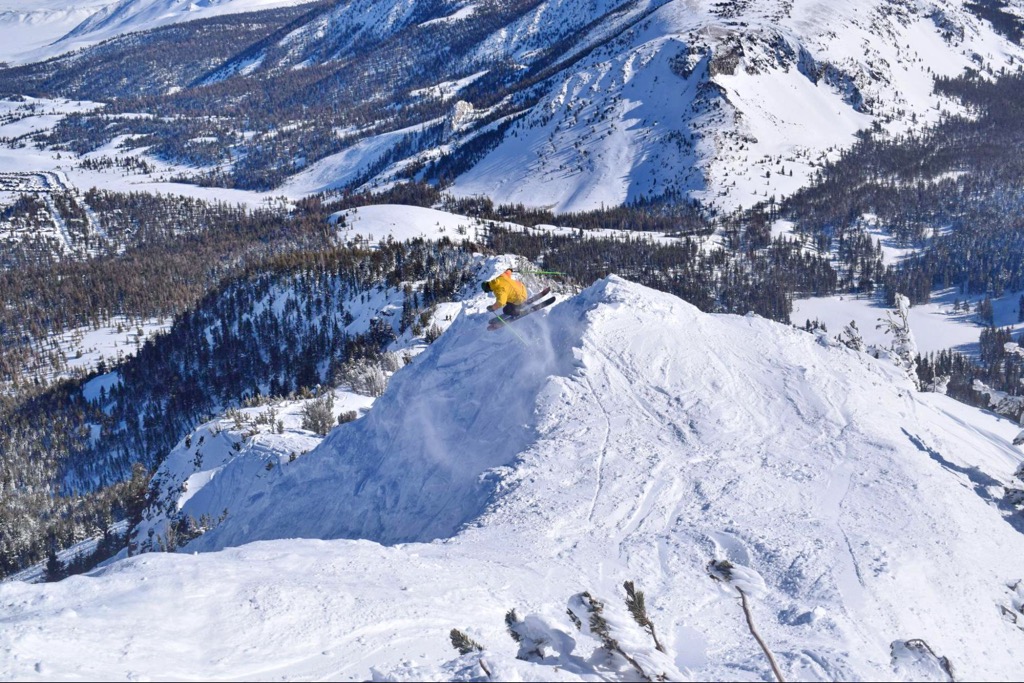
Slopes
Ski lifts
Other features and services
Mammoth’s big attraction for Nordic skiers is the Tamarack Cross-country Ski Center, just up Lake Mary Road. The center offers 19+ mi (12+ km) of groomed trails with a track. Unfortunately, these trails come at a price. Tickets are $40 per day, with slight discounts for multi-day purchases. A season pass costs $400, and Ikon Pass holders get a 20% discount.
Folks can also cross-country ski and snowshoe around the rest of the Lake Mary area for free. The trails are not groomed and not nearly as flat, but the area is beautiful, and you will be more likely to find solitude.
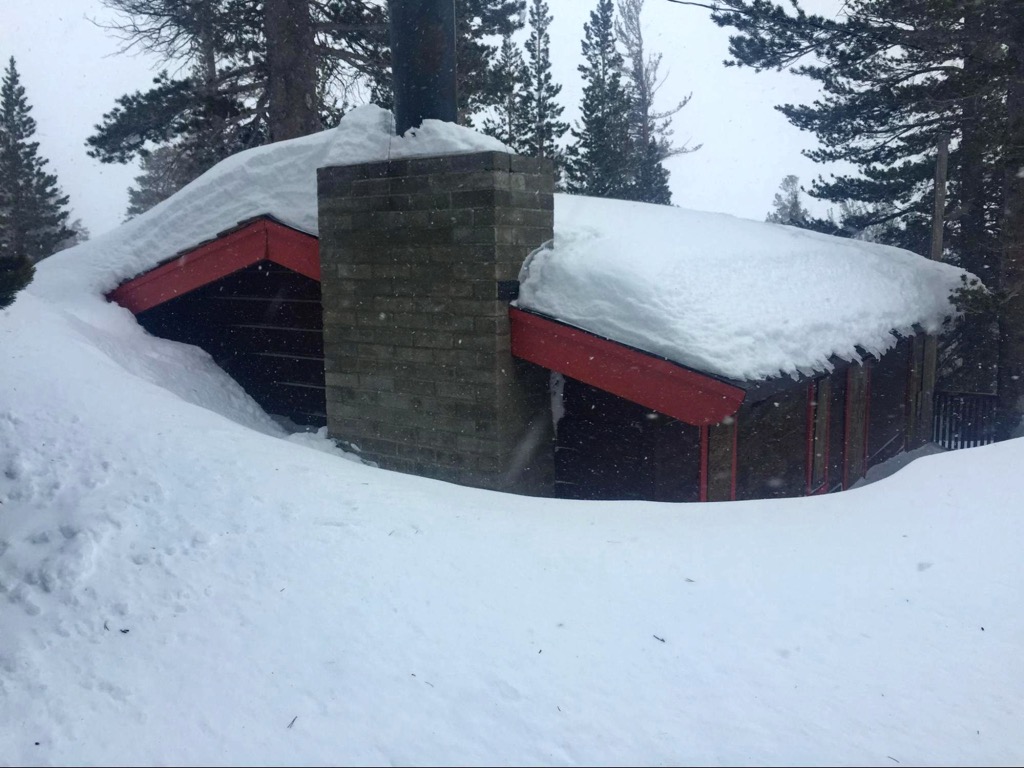
The entire Eastern Sierra is legendary as a backcountry skiing destination. It is one of the few places in North America where you can take 7,000 ft (2,133 m) vertical descents. In fact, the vertical drop from North Palisade Peak (14,248 ft / 4,343 m) to the town of Bishop is 10,000 ft (3,048 m). You can’t find relief like this anywhere else in the U.S.
But the immediate vicinity of Mammoth Lakes is not great for backcountry skiing because the town is dominated by Mammoth Mountain, which is in turn dominated by the ski resort. Backcountry skiing enthusiasts will have to drive a bit to find the goods, starting just up the road past Mammoth Mountain at Lake Mary (15 min drive).
However, the whole 395 corridor from Bishop to Bridgeport is a mecca for backcountry skiers, and several lifetimes would not be enough to ski everything here in good conditions.
The zone closest to downtown Mammoth Lakes is the Mammoth Crest basin past Lake Mary. The Lake Mary Public Winter Access trail system has some short tree shots that can be exciting on the right day. Just follow the road through Mammoth until you get to the winter closure. Continue up the road on skins, and you will eventually get to some cabins. Then, continue further, and there are some slopes mixed about.
But the biggest prizes require continuing well past this development into the alpine corridors surrounding Lake Mary. There are several aspects and terrain features, but some of this terrain can be a mega traverse back to the Lake Mary trailhead. Plus, you’re in the trees for much of the time, so it can be hard to see where you’re going. As far as bang for your buck goes, these tours are not representative of the quality of the rest of the Eastern Sierra but are close to Mammoth Lakes.
From the top of Mammoth Mountain, the Hole-in-the-Wall is accessible by traversing along the ridge toward the Dragons Back zone. Eventually, you will drop to the right and out-of-bounds rather than left into the Dragon’s Back. The terrain is a mix of trees and open meadows and offers good skiing. Eventually, the route funnels into a pass through a cliff band. This tunnel feature is the infamous Hole-in-the-Wall, a natural lava arch that offers a unique skiing experience.
After you pass through, you will continue down, passing around the lakes and ending up at Lake Mary Rd. This road will eventually take you back to town after a few miles (kilometers). You’ll have to leave a car at the blockade where the road is shut for the winter, and shuttle back to town. This line is hit so often that it doesn’t have as much of a backcountry feel anymore — unless you go first thing, anything resembling first tracks will be elusive.
It’s also possible to use the resort for lift-access touring. I have not undertaken any of these routes, but the access is straightforward if you are willing to put in the work of skiing up the neighboring peaks to the south of Mammoth Mountain. You would drop down off the back side of the mountain and skin back up from there. There are some big bowls and great, north-facing powder shots.
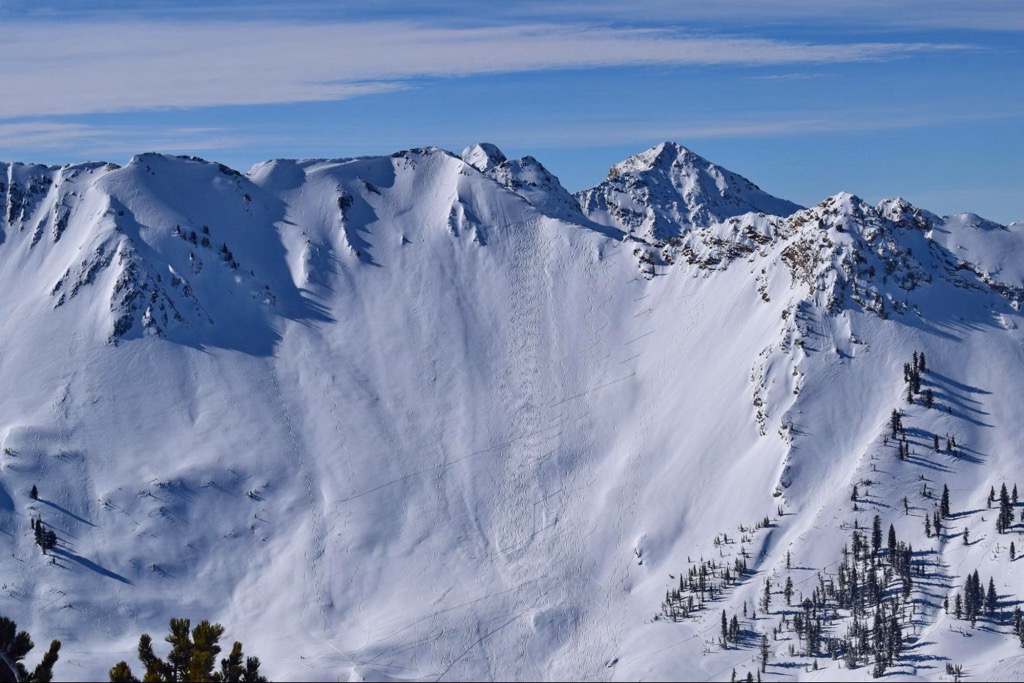
June Mountain offers the best lift-access backcountry in the vicinity of Mammoth Lakes and within the United States. Luckily, it’s still somewhat under the radar, and there is so much terrain that it is unlikely to become overrun. The serious nature of the descents and the fact that this is merely lift-assisted touring, not slackcountry, also keeps away some crowds.
Tree shots with some open terrain are easily accessible from the top of June Mountain. But the true gem is the extensive north-facing terrain accessible via a ski down from the top and subsequent skin. This terrain is no gimme and requires a fairly long (at least 1,500 ft / 450 m) vertical climb to reach. The descents are endless, and you can ski back to the road after a day on the mountain.
But not all the descents are overly serious. If conditions are stable and bright, the Negatives are the best place to start for those breaking into this zone for the first time. It’s a sizeable alpine zone with numerous different chutes and open-bowl skiing. From here, you will see endless opportunities ranging from mellow to the most extreme.
Carson Peak (10,908 ft / 3,325 m) offers some of the most extreme skiing accessible from June Mountain. With its iconic ski descents plainly visible, the peak towers over the town of June Lake. The presence of Carson Peak has truly solidified June Mountain’s reputation for stellar lift-access skiing.
“You know, I used to say the best lift-accessed backcountry terrain in California,” says Dave Miller, mountain guide and owner of the outfitter International Mountain Guides, “but a few years ago, I was talking to some friends and really thought about it and I think June is pretty tough to beat [in America].” Not bad for a resort that markets itself as “California’s Family Ski Resort.”
For the record, Dave has skied worldwide as an internationally certified mountain guide (IFMGA) and knows a thing or two about lift-accessed backcountry.
Don’t be part of the problem. Like any backcountry area, the best way to explore is to hire a guide or find a friend or a local willing to show you around. You will encounter other people out here, and they won’t be stoked if you are following their tracks or looking for beta. But if you are with a crew that knows what they are doing, pleasantries will be exchanged, and beta on conditions will be shared.
Traveling along Highway 395, any backcountry skier will be amazed at the backcountry ski potential in the Eastern Sierra. The peaks tower over the valley, littered with couloirs, faces, and even small glaciers. The Palisade Glacier, which rests in a north-facing cirque off from North Palisade Peak (14,248 ft / 4,343 m), is the southernmost glacier in North America.
These routes are serious and best attempted in the springtime. They probably won’t be part of your ski trip to Mammoth, but they wait patiently for the right person. One idea is the Mendenhall Couloir, a monster of a shot that goes from the top of Laurel Mountain to Convict Lake. It’s located just off from 395 to the south of Mammoth Lakes. The climb takes most folks 5 to 6 hours, but the descent is endless.
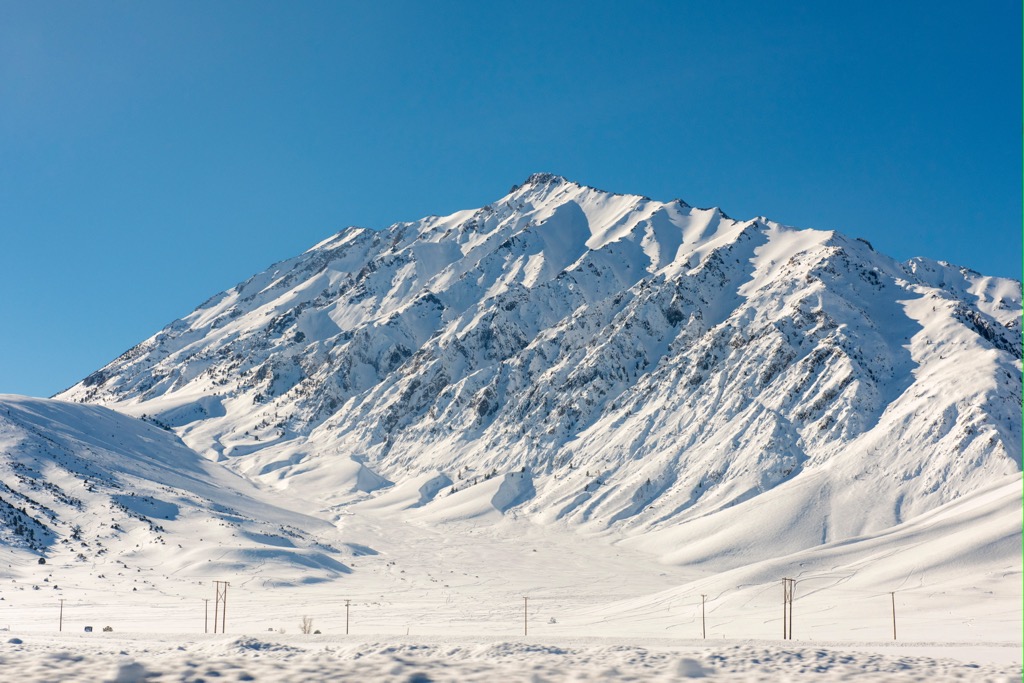
The Sierra Nevada’s proximity to the Pacific Ocean and its storm track contributes to the Maritime snowpack. This type of pack means that a skier is generally less likely to trigger dangerous slab avalanches just with their weight. There is not as much temperature gradient between the ground and the atmosphere, and facets don’t form to the same extent as in the Rocky Mountains. Moreover, these nasty early-season layers are buried under so much snow that a skier has no impact on them.
Nevertheless, skiers should always be aware of the forecast when venturing into the backcountry. The Eastern Sierra Avalanche Center is the local forecaster.
Like other resorts in the US, Mammoth Mountain Resort has several types of ski passes. Piercing can be convoluted, but the general rule of thumb is that advanced online purchases are significantly cheaper.
Day Ski Pass. Day passes vary in price depending on the day of the week, overall demand, and whether or not you are buying the ticket online. Online, tickets are anywhere from $180 to $220+, a 20–40% discount from the counter price.
The resort offers a Quad Pack for $640, and they sell multi-day passes online for up to five days, usually in the realm of $170 a day. The farther ahead you book, the cheaper the price will be. Additionally, the price decreases as the season extends into April and May.
One word of warning, however, is that travel to Mammoth can be unpredictable. The resort offers a discount for advance purchases because they know you may not show up. For this reason, I recommend the Quad Pack for folks looking to stay for a week. The days are interchangeable, so you’re not committed to specific dates if something goes awry. If you want to ski another day, buy another online once you’re already in town and know you’ll make it.
Season Ski Pass. The season pass offers unlimited skiing at two mountains: Mammoth and June. The pass is only available to buy in person at a ticket window or over the phone. The pricing is withheld online, but the pass was around $700 when I was last in Mammoth a few years ago.
Multi-Resort Ski Pass. Mammoth is one of the best resorts to own an Ikon Pass. The Ikon Pass ($1299 adult, $999 renewal) allows unlimited skiing at the resort, and the Ikon Base Pass ($919 adult, $739 renewal) allows for unlimited skiing, but with blackout dates.
Moreover, the Ikon Pass is an incredible deal because you can access over 50 resorts across North America. More than a dozen of these resorts have unlimited access — the Ikon Pass serves as their season pass, like in Mammoth. Ikon Pass holders receive other benefits, including a 25% family and friends discount on day passes and a discount on food, lodging, and retail (varies depending on the location).
Also, if you are just going to use the pass at Mammoth for a few days, it will be cheaper to buy either day passes, a quad pass, or a season pass to Mammoth plus the month of June. Be aware that the Ikon Pass has become incredibly popular and sells out before the ski season starts, so act early.
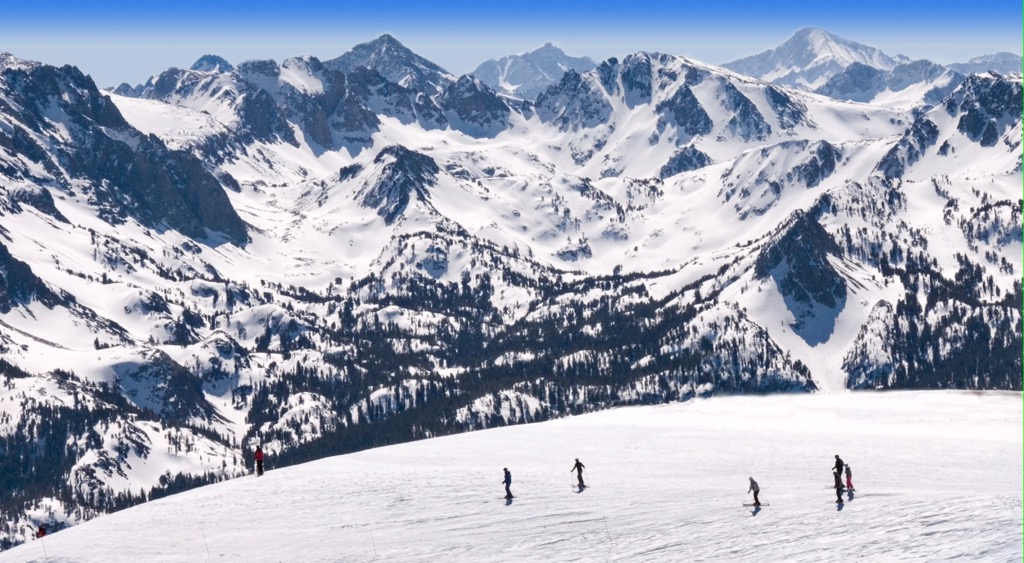
During your stay at the resort, visit the official tourist office of Mammoth Lakes town to get more information of the spots, ask an advice, and so on:
Mammoth Lakes Welcome Center
2510 Main St, Mammoth Lakes, CA, 93546, USA
Daily from 8:30 am to 4:30 pm
+17609245500
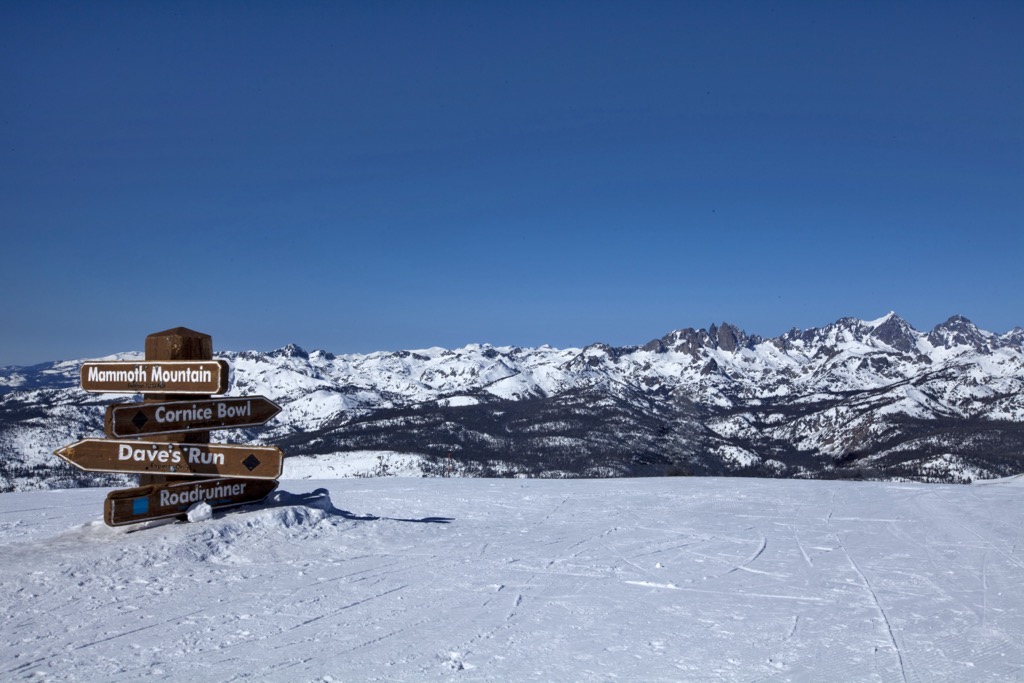
Mammoth Lakes has an average dining scene for a town of its size. For example, with its cute craft brewery, multiple Thai restaurants, hole-in-the-wall smokehouse, and farm-to-table bistro, I found the minuscule town of Driggs, ID, to have a more charming food scene. Nevertheless, there are plenty of solid American options to grab a bite after a hard day of skiing.
Mammoth Lakes has two supermarkets with reasonably priced food for those on a budget or looking to stay home and cook. There is a Vons and a Grocery Outlet, both right in town.
The Mammoth Mountain Ski Resort has a few bars and they try to coax you into staying up at the bases to buy overpriced drinks, but as usual, the quality joints are down in town, or at least the village core.
As for events, Mammoth is less happening in the live music sector than some other ski towns, but there is plenty of entertainment besides drinking.
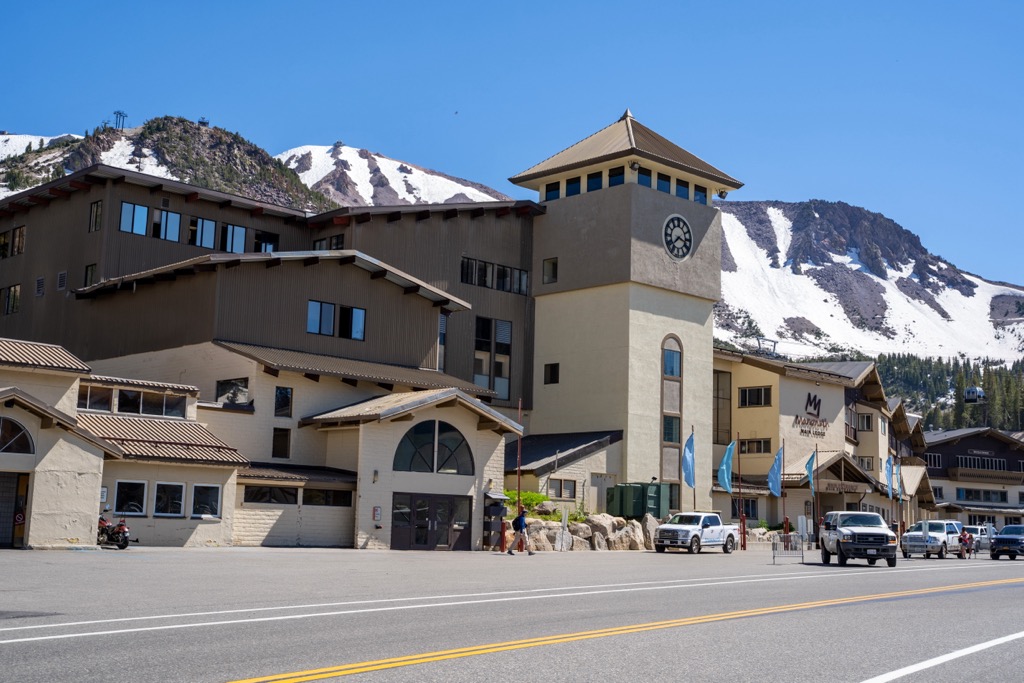
Hundreds of options are available in Mammoth. There are luxurious hotels, condos, and even some hostels. The one thing they all have in common is their high price. Come with a big group, or prepare to tap into your life savings because demand is high and supply is low.
You can also check out popular sites like AirBnb and Vrbo for more availability. These properties are located in the mountain village or Mammoth Lakes and may be a better deal than some hotel and condo companies.
The Davidson St. Guest House closed as a result of COVID restrictions. This was once the last affordable place to stay in Mammoth Lakes. Modern Hostel clocks in as the second cheapest at $150 a night during the ski season.
Dropping down from Mammoth Lakes into the Owens River Valley, the vast desert stretches before you. Visit one of the beautiful hot springs in the valley and park your van or RV for the night. It’s the last affordable way to stay in Mammoth.
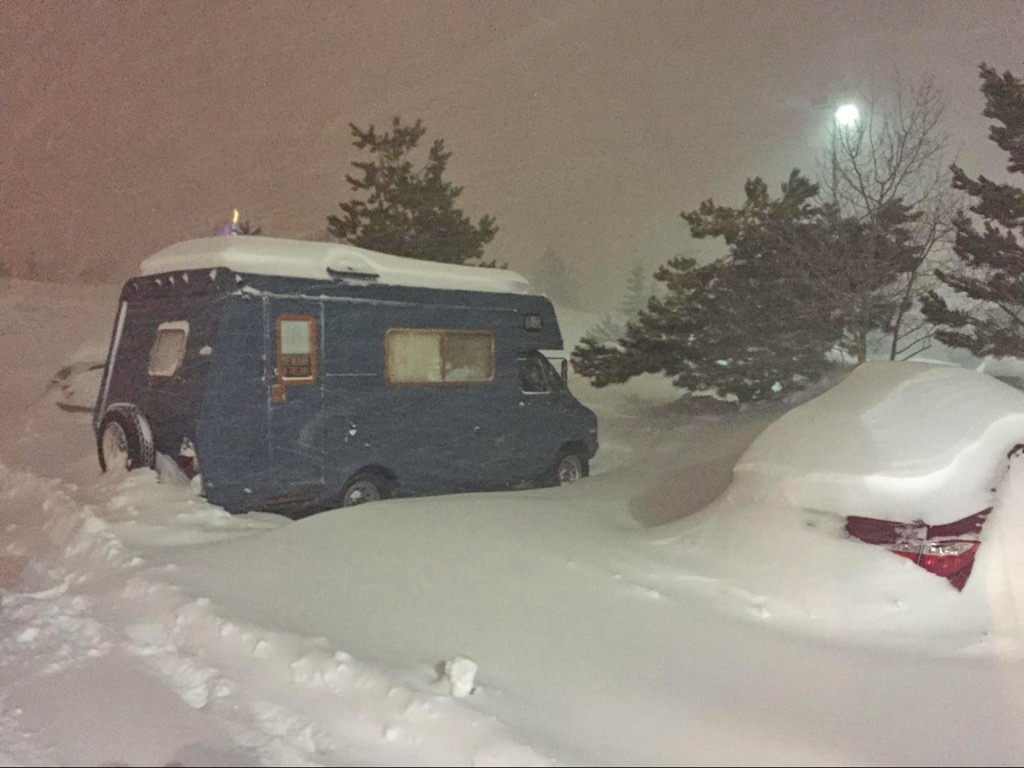
June Mountain is the main nearby ski resort and is an alternative to Mammoth Mountain. The resort is on the same season pass as Mammoth, and it is also on the Ikon Pass. Alterra Mountain Company owns both Mammoth and June.
The resort is in June Lake, California, just 30 minutes from Mammoth Lakes. It was closed for the 2012–13 season but reopened in 2013–14 with a new strategy to invest in snowmaking, a chairlift, and marketing. The resort now markets itself as “California’s Family Ski Resort” and is popular with families and beginners.
June Mountain features a variety of ski lift options for skiers and snowboarders of all levels, including 2 high-speed quads, 4 doubles, and 1 people mover for beginners. The chairlift J1, a double chair, takes visitors from the lower ticket office to the June Meadows Chalet, where most resort amenities are located. From the chalet, guests can either head down the challenging front face of the resort or continue to the intermediate upper mountain.
There are two main peaks within the ski area's boundaries: Rainbow Mountain and June Mountain. Chair J6, a high-speed quad, provides direct access to the top of Rainbow Mountain and various intermediate runs. Another option is chair J2, which leads to Stew Pot Slims, where food and beverages are available. Two additional lifts, J4 and J7, also offer access to the summit of Rainbow Mountain and the top of June Mountain.
The resort's total uphill capacity is 10,000 rides per hour, and the lifts serve 1,500 acres (607 hectares) of terrain.
For dedicated mountain folk, the big draw at June Mountain Ski Resort is the extensive lift-accessed backcountry. Many skiers consider this to be some of the finest lift-accessed skiing in the country. I already went into more detail in this guide's “Backcountry Skiing” section.
